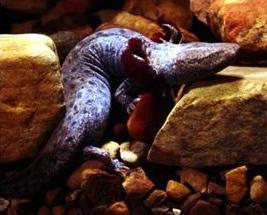Proteidae
(Redirected from Proteid)
Proteidae is a family of aquatic salamanders commonly referred to as olms or mudpuppies. These amphibians are notable for their elongated bodies, external gills, and the ability to live entirely underwater throughout their lives. The family Proteidae encompasses species that are found in various freshwater habitats across North America and parts of Europe. This article provides an overview of the Proteidae family, including its taxonomy, physical characteristics, habitat, behavior, and conservation status.
Taxonomy[edit | edit source]
The family Proteidae is part of the order Caudata, which includes all salamanders. Within Proteidae, there are two genera: Necturus, which includes the mudpuppies found in North America, and Proteus, which includes the olm, found in the caves of Europe. The exact number of species within these genera is subject to ongoing research and debate, with new species occasionally being identified.
Physical Characteristics[edit | edit source]
Proteidae species are characterized by their elongated bodies, which can range in length depending on the species. They possess external gills, which appear as feathery appendages on either side of the head, allowing them to extract oxygen from water. Unlike many other amphibians, members of the Proteidae family do not undergo a complete metamorphosis, and adults retain many larval characteristics, a condition known as neoteny. Their skin is usually smooth and lacks scales, and they have four limbs that are well-adapted for an aquatic lifestyle.
Habitat[edit | edit source]
Members of the Proteidae family are exclusively aquatic and are found in a variety of freshwater environments. Necturus species are typically found in streams, lakes, and rivers across North America, while the Proteus species, specifically the olm, inhabits the dark, subterranean waters of limestone caves in Europe. These salamanders prefer cool, oxygen-rich water and are often found hiding under rocks or debris.
Behavior[edit | edit source]
Proteidae are primarily nocturnal and are known for their secretive nature. They are carnivorous, feeding on small invertebrates such as insects, worms, and snails. Reproduction varies among species, but generally involves external fertilization, where females lay eggs in water and males fertilize them. The olm, in particular, has a very slow metabolism and can survive without food for several years.
Conservation Status[edit | edit source]
The conservation status of Proteidae species varies. Some, like the olm (Proteus anguinus), are considered vulnerable due to their limited range and the specific conditions required for their habitat. Pollution, habitat destruction, and climate change pose significant threats to their survival. Conservation efforts are in place in some regions to protect these unique amphibians and their habitats.
Conclusion[edit | edit source]
The Proteidae family represents a fascinating group of aquatic salamanders with unique adaptations to their environments. Their study provides valuable insights into evolutionary biology, particularly the phenomenon of neoteny. Despite their resilience, many species within this family face threats from human activity, highlighting the need for continued conservation efforts.
Search WikiMD
Ad.Tired of being Overweight? Try W8MD's physician weight loss program.
Semaglutide (Ozempic / Wegovy and Tirzepatide (Mounjaro / Zepbound) available.
Advertise on WikiMD
|
WikiMD's Wellness Encyclopedia |
| Let Food Be Thy Medicine Medicine Thy Food - Hippocrates |
Translate this page: - East Asian
中文,
日本,
한국어,
South Asian
हिन्दी,
தமிழ்,
తెలుగు,
Urdu,
ಕನ್ನಡ,
Southeast Asian
Indonesian,
Vietnamese,
Thai,
မြန်မာဘာသာ,
বাংলা
European
español,
Deutsch,
français,
Greek,
português do Brasil,
polski,
română,
русский,
Nederlands,
norsk,
svenska,
suomi,
Italian
Middle Eastern & African
عربى,
Turkish,
Persian,
Hebrew,
Afrikaans,
isiZulu,
Kiswahili,
Other
Bulgarian,
Hungarian,
Czech,
Swedish,
മലയാളം,
मराठी,
ਪੰਜਾਬੀ,
ગુજરાતી,
Portuguese,
Ukrainian
Medical Disclaimer: WikiMD is not a substitute for professional medical advice. The information on WikiMD is provided as an information resource only, may be incorrect, outdated or misleading, and is not to be used or relied on for any diagnostic or treatment purposes. Please consult your health care provider before making any healthcare decisions or for guidance about a specific medical condition. WikiMD expressly disclaims responsibility, and shall have no liability, for any damages, loss, injury, or liability whatsoever suffered as a result of your reliance on the information contained in this site. By visiting this site you agree to the foregoing terms and conditions, which may from time to time be changed or supplemented by WikiMD. If you do not agree to the foregoing terms and conditions, you should not enter or use this site. See full disclaimer.
Credits:Most images are courtesy of Wikimedia commons, and templates, categories Wikipedia, licensed under CC BY SA or similar.
Contributors: Prab R. Tumpati, MD

